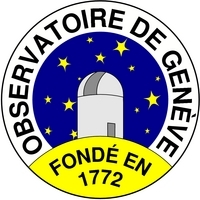
| INTEGRALPlanckGaiaPOLARCHEOPSEuclidATHENA |
| HEAVENSFACTCTALOFTSPICAJEM-EUSOXIPEeXTPTheseus |
| XRISMMAGBOUNDSMARTNet |
| ISDCCDCI |
| Data Centre for Astrophysics Astronomy Department of the University of Geneva |
The baryon content of galaxy clusters in their entire volume
| Galaxy clusters form from the largest inhomogeneities of the early Universe, and thus they are expected to retain their mass (both baryonic and dark matter) throughout cosmic time. We measure for the first time the baryon fraction of galaxy clusters in their entire volume by combining X-ray (ROSAT) and Sunyev-Zel'dovich (Planck) data. As expected, we find that the average baryon fraction reaches the cosmic value Ωb/Ωm in the outer regions, which shows that clusters are suitable targets for cosmological studies. |
|---|
ABSTRACT
Several recent studies used the hot gas fraction of galaxy clusters as a standard ruler to constrain dark energy, which provides competitive results compared to other techniques. This method, however, relies on the assumption that the baryon fraction in clusters agrees with the cosmic value Ωb/Ωm, and does not differ from one system to another. We test this hypothesis by measuring the gas mass fraction over the entire cluster volume in a sample of local clusters. Combining the SZ thermal pressure from Planck and the X-ray gas density from ROSAT, we measured for the first time the average gas fraction (fgas) out to the virial radius and beyond in a large sample of clusters. We also obtained azimuthally-averaged measurements of the gas fraction for 18 individual systems, which we used to compute the scatter of fgas around the mean value at different radii and its dependence on the cluster's temperature. The gas mass fraction increases with radius and reaches the cosmic baryon fraction close to R200. At R200, we measure fgas,200 = 0.176±0.009. We find significant differences between the baryon fraction of relaxed, cool-core (CC) systems and unrelaxed, non-cool core (NCC) clusters in the outer regions. In average, the gas fraction in NCC clusters slightly exceeds the cosmic baryon fraction, while in CC systems the gas fraction converges to the expected value when accounting for the stellar content, without any evidence for variations from one system to another. We find that fgas estimates in NCC systems slightly disagree with the cosmic value approaching R200. This result could be explained either by a violation of the assumption of hydrostatic equilibrium or by an inhomogeneous distribution of the gas mass. Conversely, cool-core clusters are found to provide reliable constraints on fgas at overdensities >200, which makes them suitable for cosmological studies.
| by Dominique Eckert on 2013-01-07 | >> Galaxy cluster science results | >> All science results |







